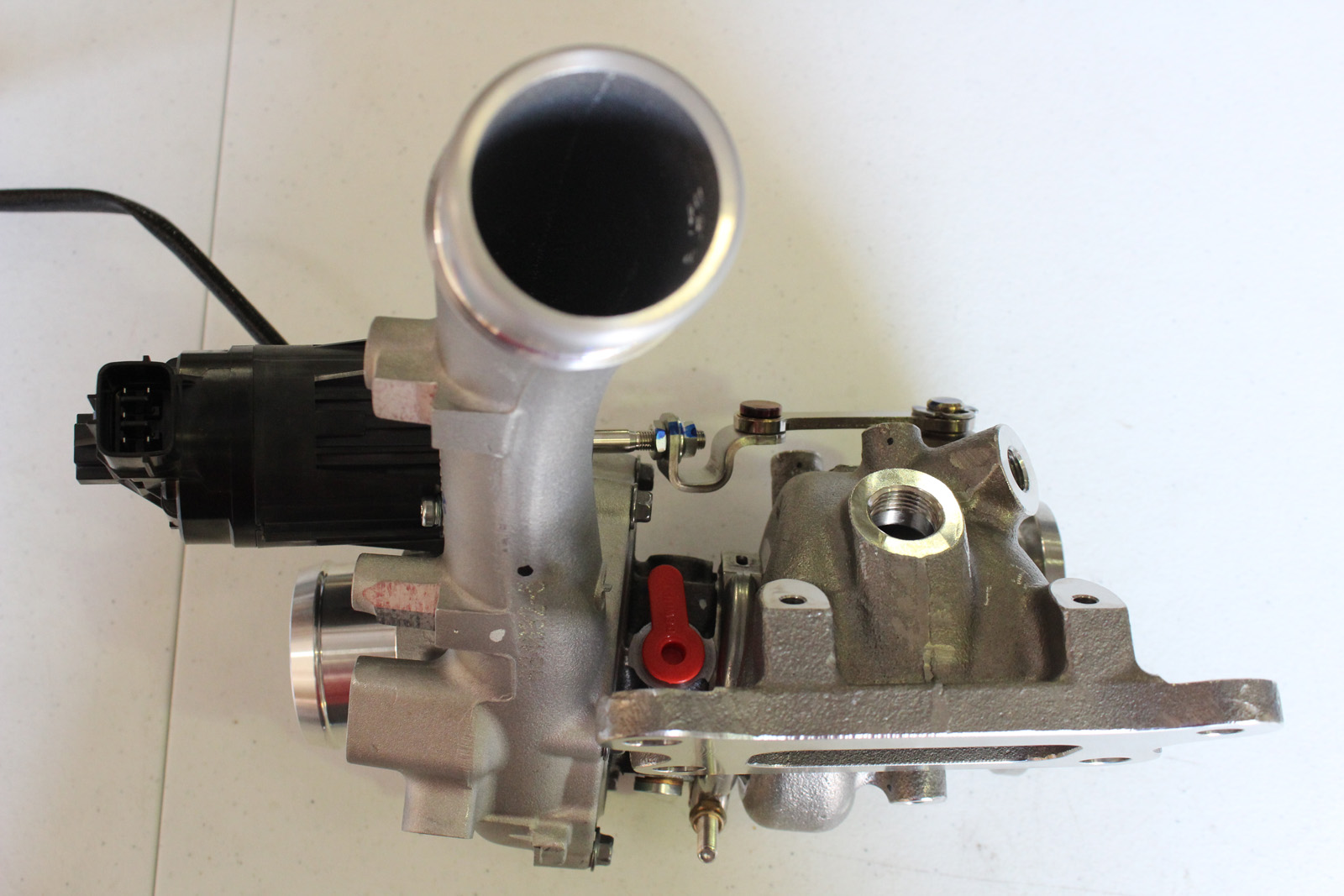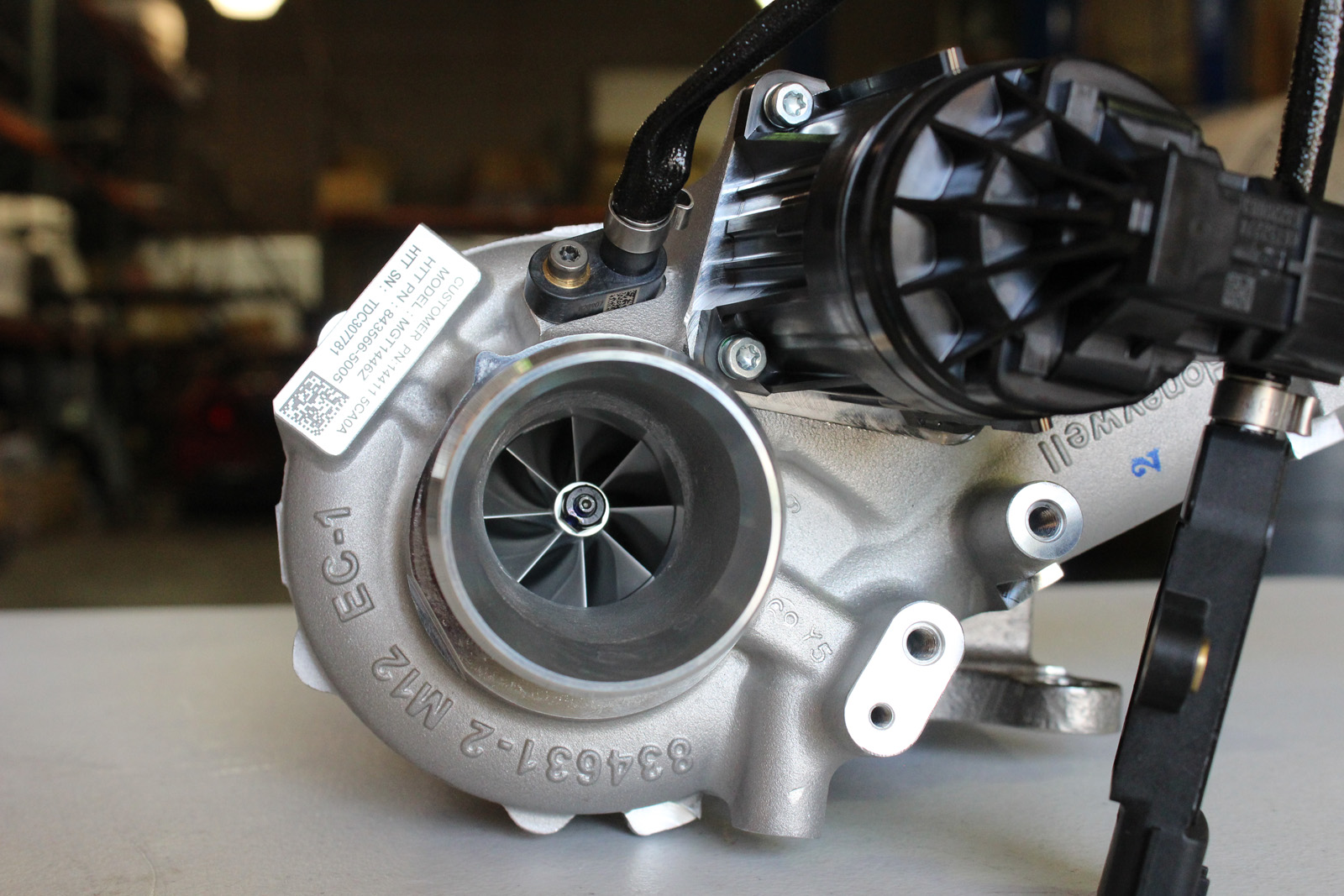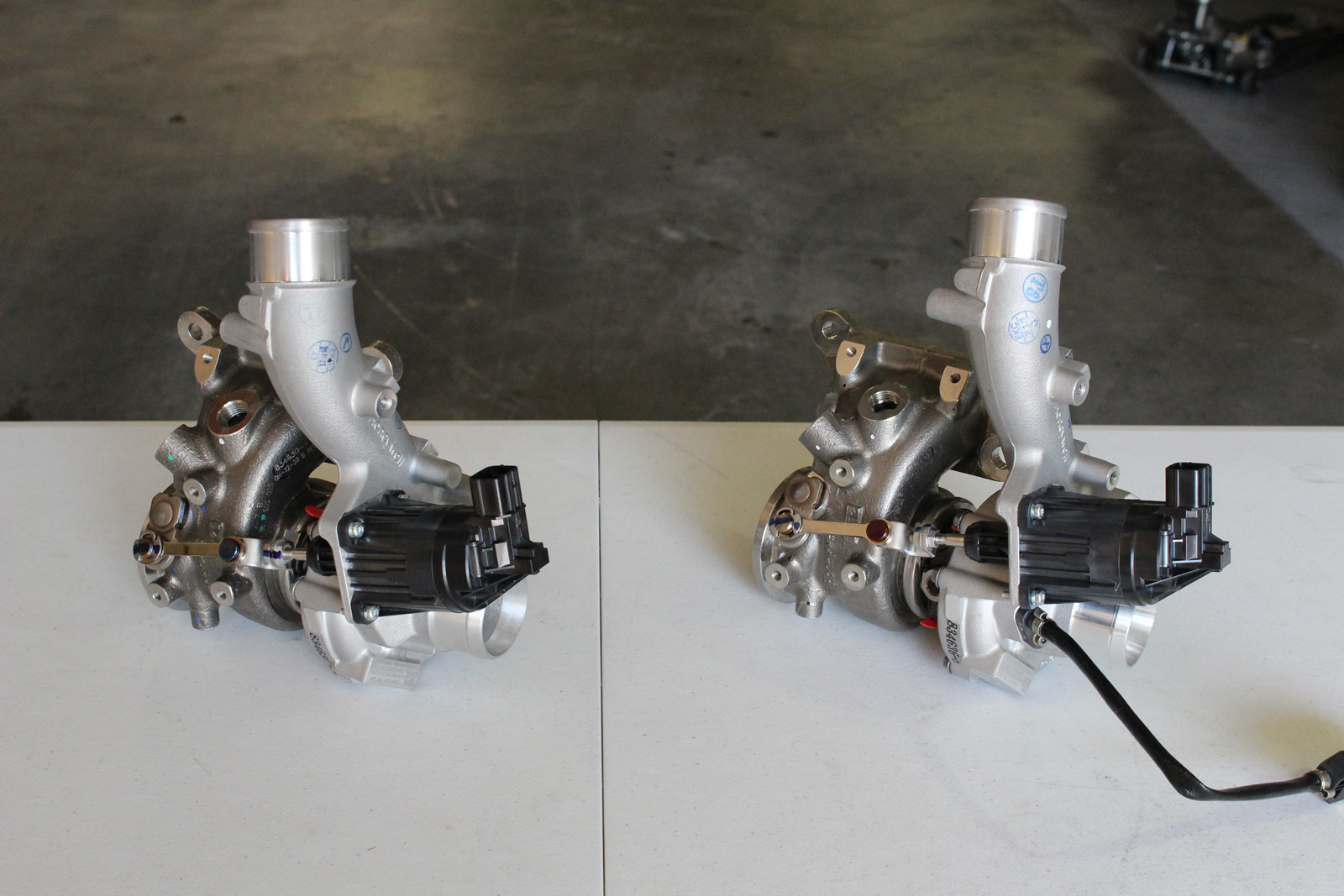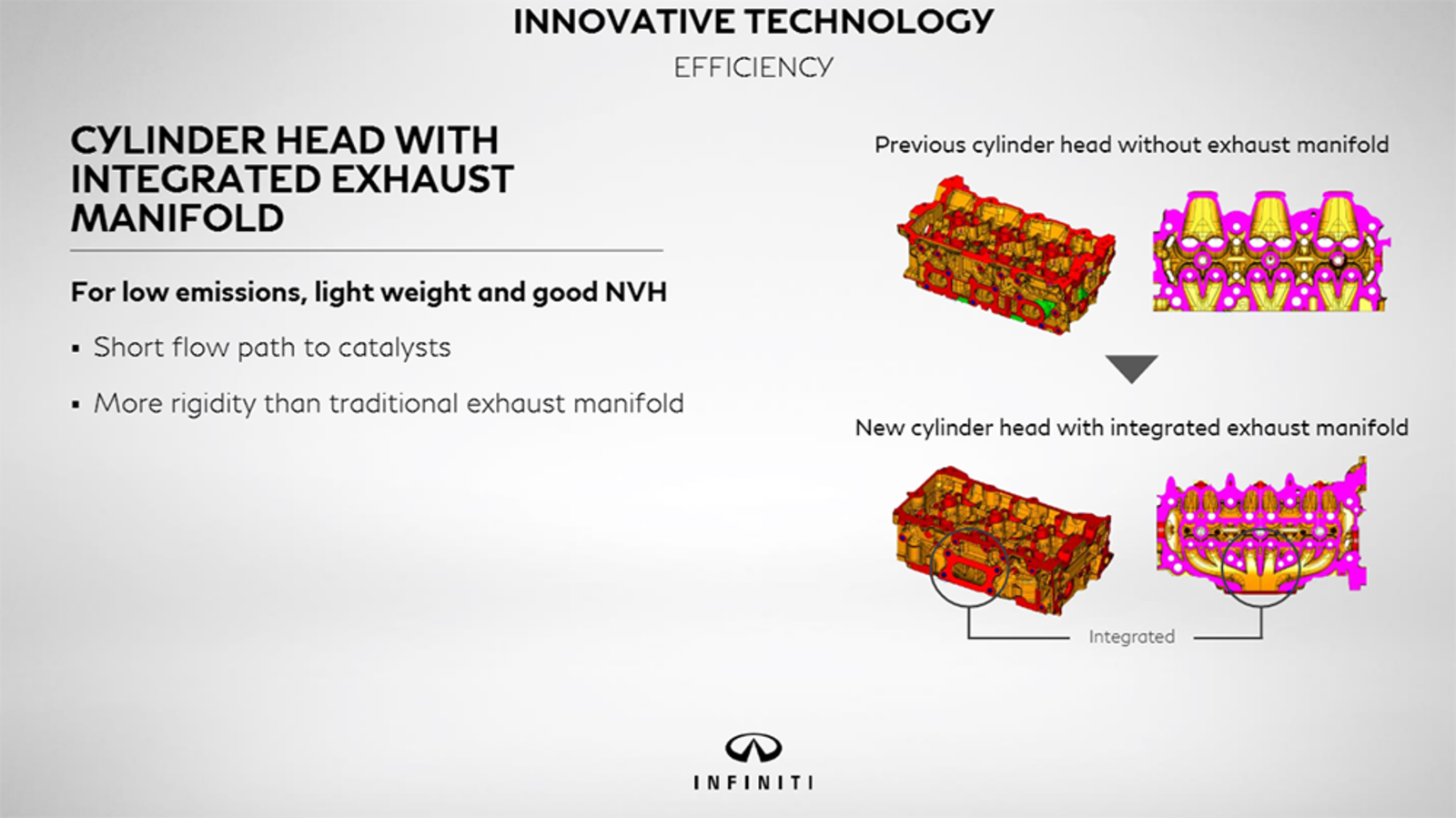Since my last article on the topic, the VR30DDTT has made it into production vehicles and has been shipping for several months. We recently picked up our own Q60 Red Sport 400 to build and develop on, and we’ve also spent some time researching the car and its components.
If you’re not already familiar, the VR30DDTT is available in two trim levels: a 300HP and 400HP variant. The 400HP in the Red Sport trim levels of the Q50 Sedan and Q60 Coupe, and the 300HP variant is used in any other model that ships with the 3.0. Infiniti says the difference in output is due to an additional cooling pump, as well as the RS400’s turbochargers having optical speed sensors to monitor compressor wheel RPM. Check out the picture below to see the two side by side.
Well, they were telling the truth: that’s the only difference. Let’s take a closer look around these turbos just to get to know them a bit better.
What you’re looking at is the FZ5t Turbo by Honeywell/Garrett. It is an MGT1446LKSZ. “MGT” is the current line of “Modern Gas Turbos,” and 1446 basically refers to the size. With no context, just know that that’s tiny. It’s smaller than stock Z32 turbos were. The MGT series also includes Garrett’s latest low-loss “Z” bearing CHRA. Nissan’s obsession with fast response certainly hasn’t changed!
These turbos have a couple of other tricks up their sleeves, too. First, like other MGT turbos (found on Ford Ecotecs and some other modern turbo engines), the rotating assembly is offset. Most likely for packaging.

Note that the CHRA is not perfectly perpendicular to the flange for the exhaust housing and compressor inlet coupler flange.
Next, can we talk about that flange? It’s absolutely massive. Which makes more sense when you understand how the turbo mates to the cylinder head. There is no dedicated exhaust manifold, but rather the runners merge inside the casting of the cylinder head, so the turbo bolts directly to the head.
Also in this flange Nissan has both an up-stream (pre-turbine) oxygen sensor as well as an EGT sensor.
Moving towards the back, you’ll see another unique change to the MGT turbos. The turbine wheel and wastegate flapper dump into an open bellmouth area, similar to Borg Warner EFR Turbos. You’ll notice the flapper also opens to dump exhaust into the exhaust stream in the same direction that it exits the turbine wheel to further reduce turbulence.
Moving on, check out the wastegate actuator. Gone are the oldschool pneumatic actuator-type, these are fully electronic.
These give the ECU a lot more control over the boost level, which is one of the things that allows the RS to push these turbos to their limit. I also find it somewhat interesting that the “bracket” for the actuators is basically cast into the compressor housing. And it’s difficult to see, but the wastegate flapper’s resting position is open. Chances are this is a failsafe to prevent the car from building boost should something go wrong, and the ECU snaps them closed when the car is powered on.
Finally, here’s the front of the turbo. There are two points of interest here:

First, check out that compressor wheel. Sure it’s tiny, but more importantly it’s billet. This makes it a hair lighter, and also increases the blade surface area without increasing overall diameter. This is what Garrett started doing with GTX turbos, so it’s nice to see this technology make its way to smaller, OEM turbos.
Also, just above the compressor wheel you’ll see the compressor wheel speed sensor so the ECU can monitor that as well.
When you take a step back and look at the complete package, it becomes pretty clear that Infiniti is basically trying to run this engine as efficiently as possible. You have direct injection, electric wastegate actuators, the RPM speed sensor, and twin coolant pumps for the water-to-air-intercoolers. They’ve set this thing up to run these turbos up as much as they can, with safety and control functions so the ECU can very carefully monitor and protect the turbos and engine.
That said, we’re certainly looking at a platform without a lot of “out of the box” room for improvement. Aside from removing emissions components (catalytic converters) and possibly intake, Nissan/Infiniti has damn near squeezed everything out of these turbos as possible.
But that doesn’t mean we won’t find a way to make more!





Will you be doing an in-depth article on the 2nd water pump and possible retrofit for the 300hp versions?
Yes! All of the parts for the 2nd water pump are available and it doesn’t look like it needs much to swap in. The challenge will be in seeing how it’s controlled and/or if the harness for the pump is on the 300hp chassis
So the question for DD becomes this. Is it better to go with a Red Sport and leave it stock or buy the regular 3.0tt, add the Down pipes, full exhaust and intake? Its about a $3000 in savings.
Also, since you have been inside of the engine bay, will having the driver assistance package (not tech, not DAS, just blind spot at intelligent cruise) interfere with possible intake, heat exchange, inter cooler, etc mods.
If you’re the kind of guy who likes to tinker, I would probably get the regular 300hp version and just mod it. But I will say, mods are scarce right now (something we’re working hard to change), and the biggest issue is a lack of available tuning tools, so while the mods out there now will make more power, the ECU is fighting you tooth and nail.
Ours doesn’t have the driver assistance package, but to be honest I don’t think it will affect any mods. There’s actually a good amount of space in the grill area, and other than the illuminated emblem, it seems basically everything is down lower in the bumper anyway.
Thats the only thing that worries me. I would like the Blind Spot but didnt want to compromise future Modding ability. The only thing that the Sport offers for me is the BBK as it comes standard and the suspension. But those are two items that Im sure can be added later on with aftermarket support. Do you think full race down pipes or just lower pipes are the better route?
There’s positives and negatives to both directions. If you’re planning on upgrading the brakes, honestly the RS isn’t a bad deal. I would say full downpipes & test pipes will be the way to go either way, though, because IMO turbine wheels are all the restriction you need in the exhaust on a turbo car.
Note : The normally open WG method reduces catalyst cold warm up time. So it reduces cold start emissions..
If you are able to place larger turbos on there, I think the water system is going to get overwhelmed. Is there room to navigate piping to the front and back into the manifold? Also, in that regard, is it possible to remove the intake coolers?
Realistically this engine is going to need bigger turbos to make any real power. They’re nearly being maxed out in stock form, and I agree the cooling system will probably need upgrading then. It’s very easy to remove the intercoolers, they’re right on the top of the engine. The problem is there is NO access in the front core support to get intercooler piping through, so switching to traditional Z32 or R35 air-to-air setup is not really feasible in any kind of bolt-on application, so we’ll be left with upgrading the existing liquid cooling system.
Nick, good afternoon:
Is there anyway that the stock turbos can be upgrades in order to put out more flow? Also is this car using the same G37/Q60 Transmission of the past and if it’s the same. Do you think it has been upgraded not only in terms of internals upgrade but in the software itself too? Thanks!
We actually originally bought one to see if there was any room for improvement in them, at least to throw billet wheels in there. But, as you saw, they already had them. So I’m not really sure what could be done to upgrade the stock turbos.
Transmission is a different part number, I’m guessing there were some minor changes done to it but it’s largely the same as the G37 7-speed.
Will bigger turbos fit? Or does it seem this is the biggest size possible given the limited space in the engine compartment?
That we don’t yet know! The turbos are so unique that it’s going to take a lot of custom work no matter what.
VERY NICE!!! i love my q50s red sport, the turbos really make it come alive, great article! looking forward to intake kits and gtr type exhaust kits to come in the future for this thing
What I would love to know is what this bolt on, ECU controlled turbo uses for control (simple piggyback or is it a nice plug and play for the stock ecus in z32 300’s).
Following!
It’s controller directly by the ECU on the Q60/Q50, there’s currently no other control system for it.
Do you know of any potential aftermarket turbos from Garrett/Honeywell for the Q60?
Not yet! They seem to share some DNA with some modern Garrett turbos in Ford/GM applications, most of which are paired to I4s and are a bit larger, so there’s hope. But the housings on the Q60 appear to be totally custom, so it’s going to take a lot of work to make ANYTHING fit.
Nice article. Let me know if you are interested in the turbocharger speed sensors. By reducing the safety margins, it improves the peak power and low end torque.
Now you have our VR30DDTT Tuning Suite Nick, looking forward to seeing how things develop.
Me too, I’m excited to see what this car can do without the ECU fighting us tooth and nail!
Do the two turbos make the same sound as the original 1990 300zx tt car or do they make that sickening high pitched sound that you often now hear?
Also my Son is considering buying front and rear stabilizer bars and noticed two prices one cheaper than the other the other looks like has a few more parts. What is the difference which one should he get for his 1990 300zx NA car? He did a suspension upgrade not too long ago and may have already done the extra parts. Not sure though. He did a camber kit is that what that is?
Honestly with the stock induction stuff, you can’t hear them at all. Nissan doesn’t want customers to hear them because the moms buying the Neiman Marcus Q60 would just bring the car in thinking there was something wrong 😉 We’ve done some testing with different air intakes and they get pretty loud pretty fast, but they are small turbos so it’s still fairly high pitched.
As for sway bars for the 300ZX, I’m guessing you’re seeing the ST and Stillen Swaybar kits? If so, they’re actually the exact same thing, I believe ST manufactures them for Stillen, so you really can’t go wrong either way.
Will the q50 red sport waste gate and each handle cat back exhaust with down pipes without tune? Or is that pushing it a little too far?
Ecu** not each. Sorry auto correct.
It works, but the ECU fights it a lot, so the power output from it is really inconsistent. On some pulls it would put down a good amount more power, on others it puts out less because the ECU starts dialing things back. So you really need a tune to benefit greatly from them.
Will that cause any problems later on? I have a three year lease and don’t want to throw any codes or have my ecu give out on me
I’m guessing as long as they don’t look at the ECU, as far as I know EcuTek doesn’t let you return it to stock yet 😉
Yeah, I won’t be tuning. A catback and either some DPs or intakes will most likely be the end for me as far as upgrades go (my wife will kill me). As long as DPs and my catback don’t throw a code or give me any tranny issues, I’m all for it, if it seems too much of a risk, then some intakes will have to do
I will be upgrading both turbos if I have to use the sensors from the stock turbos and make them work on the ones…then so be it.
Only one problem, the car floats terrible at 200km/hr and nearly crashes it’s really scary. Not sure if I want to put that kind of money into it. Wish it had the rack option and not the das. If you know anything about this please advise. Thanks
Been quiet for a while, but: Have you taken off that turbo speed sensor and looked at the working end? All the factory hype was OPTICAL turbo speed sensor, but there was some insider information that it ran on electrons, not photons. If it weren’t for those CHEESY crimp-on clamps holding on the cable jacket, I’d say that was a Jaquet DSE 605 eddy current speed sensor, or some OEM perversion of same.
I actually just tried, even with the right bit the screw tries to strip, so I’m guessing it’s got threadlocker on their. But I would agree that it looks like a regular hall effect sensor, not an optical sensor.
In that case, have you pulled the compressor cover? And can the sensor tip entry point be clearly seen (it sure looks like you could)? Anything that resembles an optical window, as opposed to a solid metal or plastic face? My apologies if that’s what you already answered in your response, but I was saying the externally visible part looks very familiar, whereas you may or may not have meant that the working end looks regular, too.
Nice!, I installed a turbo (holset hx35/40) on my 350z and the truth that I am completely regretful, I do not know if is the turbo, but I do not feel my car fast , I miss the aspitated sound of my vq35 🙁 A friend say that this holset is to big I don’t know what to do T_T, would you recommend to change the turbo to another smaller? the tune was done with aem piggyback and the afr is in the range of 11.5-12 when I drove it hard, Thanks!
Hi, So I have gotten a 2017 Q50 last OCt. I have it tuned w Ecutek/BMS HX/HKS blow offs/Stillen rear sway/AEM intakes/Tanabe pipes…..puts 430hp/470tq to the wheels…..The tune solves the ECU fighting all the time and opens this car up. I can tell you that this car is a friggin beast with a tune and some mods….wow….Nick, have you done anything else researching this car?
The horsepower is amazing in both the variants. They churn out so much of power. Great piece of engineering. Sensitive and accurate sensors are also used. Enjoyed reading the article. keep posting. Thanks.
So will the RS turbos fit on my non red sports
I’m maxed out at 450hp and 500tq on my 2018 q60. With Alpha heat exchanger maxed
The RS turbos aren’t any larger. They are identical except for the speed sensor.
From what I’ve seen/read, with a tune, the Silver Sports and Red Sports put out nearly identical power. It’s just that the Red Sports are tuned to produce more boost stock, but a tune puts both at about the same level.
Correct, I’ve actually learned since this article that the 400hp variant was designed first, and was later de-tuned for the 300hp variant. The engines are identical, the differences are the turbo speed sensors, second water pump on the RS for the intercoolers, an oil cooler on the Sport model, etc. The 300hp version runs about 9.5psi and produces approximately 350hp at the crank, and the 400hp version runs about 14.5psi and produces about 420hp at the crank, as we’ve found through our own testing.
Do we need Blow Off Valve on this car? Saw hks but it is vent to environment so isnt it would introduce turbo lag? Thanks
Yes, venting to atmosphere will increase lag between shifts, we’re hoping to see a recirculating kit in the future, since it does help reduce surging at higher boost levels.
Folks with higher boost and running the Stillen air intake WITHOUT a BOV are reporting hesitation, especially when letting your foot off the gas. The ecutek tune tries to account for this with custom code (the “Gearchange-Wastegate Offset” according to the Ecutk manual) to adjust the wastegate. But this does not seem optimal. The central question is: “Does the VR30DDTT engine come FROM THE FACTORY with a mechanical “Air Diverter” (Blow off valve) on the INTAKE side (not the exhaust/wastegate side)? IF not – then it would sem that a recirc BOV similar to the Synapse would be the best compromise between NO BOV and full dumping to atmosphere? in order to combat Boost creep/boost spike?
Nope, there is no form of recirc or diverter valve in the factory config whatsoever. It’s a straight shot from the turbo outlet to the intercooler, and intercooler to throttle body. There isn’t even a “pop-off” valve on the manifold. These cars overboost between shifts as a result, but it hides it well enough. But we are seeing with raised boost levels, a combination of EcuTek’s wastegate offset and BOVs tend to help reduce the issue.
A very useful article to read. Thanks a lot for sharing this. Fine work. Keep it up.
Hi, thank you for your work. I have this motor and I removed the catalysts. There was a problem with blue smoke.
This usually happens with a quiet ride. if you drive fast there is no blue smoke. I heard a lot of opinions on this. Someone says that initially the turbines have a weak cartridge and oil gets into their hot part. some write that the impeller needs support.someone says that blue smoke and oil in the hot part of the turbines is normal. I am thinking about removing catalysts. and further work on the machine, but first I want to study this issue.
In our country there are not many of these engines. and not many people who understand them. and I think if I can solve this problem by creating a backwater for the turbine. By installing sports catalysts in 200-300 cells. or is it a turbine problem, and need to look for another way ?.
We’ve experienced similar issues on other platforms, but it’s pretty much always a result of bad turbos. The turbos don’t NEED backpressure from the catalyst, but having the cats in place burn off that oil vapor and prevent it from being noticeable.
Yes, I studied the issue for quite some time. They say the problem is in the turbine itself, namely the plastic parts in the middle.
Yes, I studied the issue for quite some time. They say the problem is in the turbine itself, namely the plastic parts in the middle.
great article, thank you very much for your input and knowledge 😉